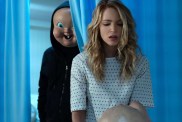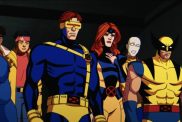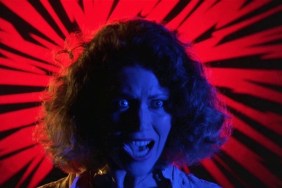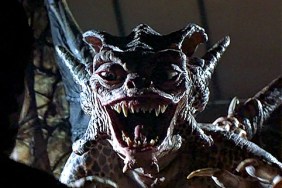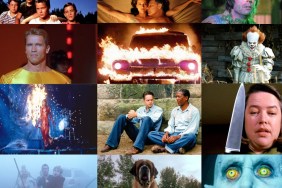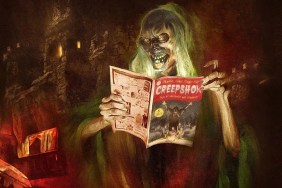
George Romeros Tales From the Darkside television series was born from an inability to follow up Creepshow II. Warner Bros. still owned certain rights to the franchise, and Romero (along with producing partner Richard P. Rubinstein) came up with a way to circumvent the studios grasp on their William Gaines-influenced classics. Utilizing Rubinsteins Laurel Entertainment, the longtime creative team hired actor Bob Balaban (who most knew from Steven Spielbergs Close Encounters of the Third Kind) to direct Trick or Treat, a half-hour teleplay Romero penned with Franco Amurri. The pilot aired on October 29, 1983, and Paramount Television picked up the series for broadcast the following year, where it gradually became a sleeper success.
By 1986, Laurel Entertainment had set up a rather unconventional studio in East Los Angeles, where they were able to shoot episodes inside of a converted mattress warehouse. While the major networks anthology stabs had either produced tepid ratings (Amazing Stories) or been cancelled outright (Alfred Hitchcock Presents), Romero and Rubinstein were able to produce a successful show the only way they knew how by keeping it cheap and under their control. Often employing nonunion crews and reducing the total budget to a little over 10% of their network counterparts (for comparison an episode of Darkside would run $124,000, whereas an Alfred Hitchcock Presents installment could top out over $1 million), the DIY style Romero championed throughout the entirety of his feature career was carried over to the small screen.
Sometimes, the effects budgets would run as low as $188/episode, relying on the ingenuity of the young creative talents on set (who were also working for bupkis) to come up with inventive ways of scaring the crap out of their viewing audience. Rubinstein continued his brash sales tactics, licensing the show to twenty-five foreign countries, while simultaneously releasing episodes to rent on videocassette. It was the same combination of tenacity and shrewdness that paid off for the horror mogul time and again. But the real draw was Romero and his writers playful, often campy approach, attracting the likes of Stephen King and Clive Barker to lend their material for episodic adaptation.
Unfortunately as all good things do Tales From the Darksides success came to an end. In 1988, Laurel Entertainments stock was trading at nearly half the rate as the year before. The company was now registering losses in the six digits, compared to the $1.5 million in profits it reported in 1987. Competition had also sprouted in the wake of the minor sensation, as studios began churning out their own Tales From the Darkside knockoffs (such as New Line Cinemas Nightmare on Elm Street spin-off, Freddys Nightmares). Meanwhile, Romero had gotten back into feature directing, signing up with Orion Pictures to make Monkey Shines. So Rubinstein and Laurel Entertainment did the only thing you can once your first run horror anthology series begins to flounder: you take it to the big screen.

While Romero was off struggling with a studio that was facing its own fiscal difficulties (Orion would declare bankruptcy just as The Dark Half hit theaters in 1993), his former Creepshow/Day of the Dead assistant director stepped in to helm Tales From the Darkside: The Movie. Like Rubinstein, John Harrison was a consummate creative partner in the Romero Film Family, acting as the horror icons right hand on two of his best pictures, composing the score to Creepshow, and writing/directing several episodes of the Tales From the Darkside series. If anyone could be trusted to retain the same Romero flavor (not to mention several key crew members), it would be the man who helped create some of the filmmakers most iconic work. Its no wonder Tom Savini whose former gut boy, Greg Nicotero, and the rest of the KNB crew (with a consult from the legendary Dick Smith) were heading up effects duty would later publicly call Tales From the Darkside the real Creepshow III.
Featuring three individual stories introduced via a tidy wrap-around, Tales From the Darkside: The Movie is undoubtedly one of the best anthology pictures of any genre. Beginning with little Timmy (Joeys brother, Matthew Lawrence), who finds himself locked inside the hidden dungeon of a suburban witch (Blondie/Videodrome goddess Debbie Harry), its quite clear that were rooted firmly in the same EC Comics reality that not only informed Creepshow, but also Night of the Living Dead. Timmy must find a way to stall the sorceress, as shes planning to pop him in the oven as the main course for a coven dinner. Lo and behold, there just happens to be a gigantic, leather-bound tome titled Tales From the Darkside sitting in his musty cell, and Timmy uses the torrid fables to buy him a little time as he schemes on how to get the hell out of this picket fenced prison.

Lot 249 is the first diversion that catches the boys eye. In it, Arthur Conan Doyles 1892 quickie comes to life, as graduate student Bellingham (Steve Buscemi) is waiting on an Egyptian Mummy to be delivered to his room. Little more than a tweedy archetype, the poor putz is unknowingly plotted on by classmates Susan (Julianne Moore) and Lee (Robert Sedgwick), both of who are out to swindle the poor study of a coveted scholarship. Once he discovers hes been cheated, Bellingham reanimates the ancient corpse, commanding it to murder his enemies. This understandably raises the ire of Susans brother Andy (Christian Slater), who kidnaps the corpse-wielding nerd and threatens to destroy his new prized possession. As is the case in all of these fictions, nothing is ever that simple, as Andys inability to commit the same atrocities as the bullied student comes back to bite him in a most ironic fashion.
From the get go, its apparent that Harrison has expertly preserved the style of the TV series, right down to the shocking twist ending. Utilizing a script by Michael McDowell (Beetlejuice), Lot 249 is an incredibly neat segment in the truest sense of the descriptor. Theres an economy at play in the storytelling thats astonishing, as McDowell keeps the tale compact and contained. Cinematographer Robert Draper who shot fifteen Tales episodes for TV, as well as Halloween 5: The Revenge of Michael Myers perfectly understands that each story has to have its own feel. With Lot 249, Draper creates a rich, mahogany hue that is bathed in warm browns, selling the world of the warring, over-privileged students with ease.

Timmys second story deepens the Creepshow connection. Cinematically tailored by George Romero from a Stephen King text (The Cat From Hell), the segment was originally supposed to appear in Creepshow II, but was cut for budgetary reasons. A wheelchair-bound pharmaceutical giant (William Hickey) summons a hit man (David Johansen) to his mansion, offering $100,000 to take out a rather bizarre target: a single black cat. The old man believes that the cat is responsible for the murders of his sister (Dolores Sutton), her friend (Alice Drummond) and the family butler (Mark Margolis). The beast is taking revenge for the five thousand felines the geezers company sacrificed while testing their latest drug, and the cat proves to be quite crafty, stealthily driving the hit man crazy right up to the storys grotesque climax.
Of the three segments, The Cat From Hell feels the closest in spirit to Romeros original anthology classic. Bathed in blue, theres a chilly, omnipresent air of cartoonish dread. Were one to be forced at gunpoint to tonally equate the story to an original Creepshow segment, the most obvious contender would be Fathers Day, as it contains a similar shameless joy of watching obnoxious bourgeoisie get their due comeuppance. However, Cat From Hell is meaner and owns a rather sadistic streak, the titular feline somehow transforming into a vengeful movie monster in it own right.

As all anthologies should, Tales From the Darkside saves the best story for last. Lovers Vow finds Michael McDowell returning to the typewriter and bringing a book of Japanese folklore with him. The only fable not directly adapted from a previously existing source, Lovers Vow is nevertheless drawn from legends of the y?kai bewitching monsters and spirits. Preston (James Remar) is a despondent artist who witnesses a gargoyle committing a murder in a back alley. In order for the beast to spare his life, Preston must swear to never tell anyone about its existence. The artist agrees, and soon finds his life taking a turn for a better. He meets a beautiful woman (Rae Dawn Chong), whom he marries and fathers two children. His art begins to sell incredibly well, even as memories of the monster haunt and influence him privately. He has to tell someone and letting the secret slip will spell doom for all he holds sacred.
The creature design in Lovers Vow is the most striking aspect of Timmys final tale, and a reminder of how much fun practical movie magic can be. Remar isnt interacting with a slimy reptile comprised of numerous pixels. The ghoul is a bug-eyed nightmare brought to tangible life, and you can feel the beast sharing the frame with the actor. Its an incredible creation, cementing an iconic element into an already solid anthology motion picture.
Tales From the Darkside went on to become a modest hit at the box office (nearly $16 million on a budget of $3.5 mil), but it wasnt enough to save the franchise. A sequel was announced in October of 1990, written by Michael McDowell, George Romero and Gahan Wilson. The stories set to be included were adaptations of Robert Blochs Almost Human, as well as Stephen Kings Pinfall and Rainy Season. Unfortunately, this follow-up never came to fruition, and what horror fans are left with is something of an unofficial trilogy, pieced together between two major studios (Warner Bros. and Paramount) and a ton of independent know how.
A CW reboot of Romeros TV series was announced in February 2015, with Stephen Kings son, Joe Hill, pegged to pen the series pilot. It was recently revealed the network has decided not to go to series. Sad, as a new generation needs their weekly-televised dose of EC Comics, and Hill just might be the guy to resurrect it.
—
Jacob Knight is an Austin, Texas based film writer who moonlights as a clerk at Vulcan Video, one of the last great independent video stores in the US. You can find find him on Twitter @JacobQKnight.

